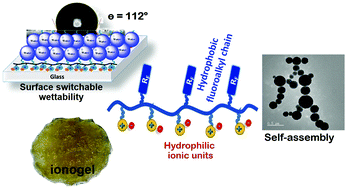Self-assembly of fluorous amphiphilic copolymers with ionogels and surface switchable wettability†
Abstract
Fluorous amphiphilic copolymers were synthesised by the microwave assisted copolymerization of 1H,1H,2H-perfluoro-1-octene and vinyl imidazole and characterized using size exclusion chromatography, FT-IR and 1H, 13C, 19F, and DOSY NMR. The fluorous amphiphilic copolymer, when coated on a glass surface, exhibited a water contact angle (WCA) of 112°, compared to that of 67° obtained for ionic homopolymers (poly(vinylimidazolium bromide)). Switchable wettability was controlled by tuning both ionic groups and the hydrophobic fluorous segments in the amphiphilic copolymer. The fluorous ionic copolymer offered a variable WCA of 112°, 107° or 97° depending on the surface hydrophobicity of the substrate, such as glass, a compressed carbon sheet or a Teflon surface, respectively. These amphiphilic copolymers self-assembled in different solvents and swelled. The swelling was up to 966% in water and methanol and up to 2036% in DMF with fluorous anions. The micelles formed from the self-assembly of amphiphilic copolymers in different solvents were characterized by dynamic light scattering (DLS) and cryo-transmission electron microscopy (cryo-TEM). Furthermore, Ag nanoparticles were coated on the amphiphilic ionomer and characterized using scanning electron microscopy and atomic force and electrostatic force microscopy.



 Please wait while we load your content...
Please wait while we load your content...